German Shepherd vs Doberman Pinscher: Are Alsatians the Best Dogs, or Are Dobermans better?
Are you in the market for a guard dog? If so, which breeds are you considering?
Maybe you prefer the classic German Shepherd, whose popularity hasn’t waned much since the days of Rin Tin Tin.
Besides satisfying our natural curiosity, comparing dog breeds is an important part of due diligence before adopting a new family member.
In this article we’re going to evaluate the similarities and differences between one of the most popular family dogs – the German Shepherd, and a close alternative – the Doberman Pinscher.
German Shepherds and Doberman Pinschers actually have much more in common than you might think!
We’ll go over sizes, talents, temperament, personality, appearance, health, and much more.
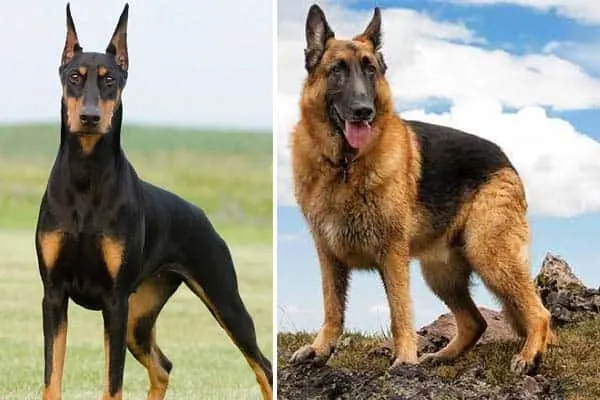
Both German Shepherds & Dobermans Have German Heritage
Louis Dobermann developed the Doberman Pinscher in Thueringen, Germany, around the year 1890.
Shortly after that, around 1899, Max von Stephanitz was busy perfecting the ideal working dog from a champion he discovered at a dog show.
The Doberman and the German Shepherd later became registered with the American Kennel Club in 1908.
What Are The Standout Physical Attributes Of German Shepherds & Dobermans?
Both GSDs and Dobermans are large and powerfully built – but not to the point of becoming slow or clumsy due to excess weight.
They’re exactly what you’d want to see in effective guard dogs.
The word ‘athlete’ should immediately strike you when you look at either breed. The pair possess grace, keen alertness, and ground-covering, efficient strides.
Both breeds are traditionally black and tan – the Doberman with brown or rust points, and the Shepherd with a black saddle and facial ‘mask’.
How do their appearances differ?
The Doberman, at 26 to 28 inches tall, somewhat towers over the 22 to 26-inch tall GSD. Dobermans have more of a square build compared to the German Shepherd’s rectangular and sloping silhouette.
Both dogs weigh in the range of 75 to 95 pounds, giving the German Shepherd a stockier appearance than the Doberman.
The Doberman’s muscles, however, appear more defined than the Shepherd’s. In each breed, the male should be larger and more muscular than the female.
Color variations differ as well. German Shepherds can be solid red, tan, black, or red and black. Less common coat colors you can also see are white, blue, silver, and liver.
Here is a complete list of standard and rare German Shepherd colors.
Dobermans can be blue, fawn, or tan in addition to black, but they’ll all have rust or brown markings in certain areas such as above the eyes and on the lower legs.
Although quite rare, white Doberman does exist as well.
Sometimes a video makes it easier to visualize
This video collection does a good job of showing the athleticism of the dogs and the marked differences in attack styles.
You also get a good feel for training commitment, exercise requirements, and grooming challenges.
Adult German Shepherds should have large pointed ears that stand up effortlessly. Many Dobermans’ ears are cropped or trimmed at a young age and actually look similar to GSD ears.
Like the dog’s arched neck, however, the ears appear sleeker and more refined than a Shepherd’s.
If you don’t crop your Doberman’s ears, they will fold down near the base, tending to be wide and floppy but not excessively long.
In the United States, Japan, and other countries where it’s legal, Dobermans usually have docked tails.
Docking means the breeder or veterinarian cuts the dog’s tail to the breed-specific standard length when the pup is a few days old.
If you happen to have a Doberman with a full tail, it will be medium in length and rope-like, curving gradually upward from the midsection to the tip.
On the contrary, German Shepherds have a long plush tail that they carry low unless working or showing emotion.
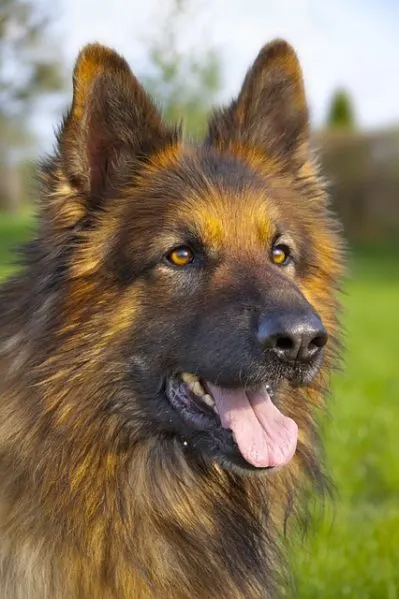
There Are Unexpected Effects Of Appearance On Grooming
One of the most significant differences between Dobermans and German Shepherds is coat length.
Although a German Shepherd’s coat can vary quite a bit, most have medium to long hair with a dense undercoat.
A few have long hair with no undercoat or short hair with a wooly layer underneath. Most are not like Dobermans, who usually have a short sleek semi-course overcoat with a second layer of soft, thin fleece.
German Shepherds require more grooming than Dobermans, but both breeds need regular brushing to keep the undercoat in check.
| Image | Title | Buy |
|---|---|---|
 Top
Top | FURminator Undercoat deShedding Tool, For Medium Dogs, Long Hair | Buy Now |
 Top
Top | Yabife Dog Clippers, USB Rechargeable Cordless Dog Grooming Kit, Electric Pets Hair Trimmers Shaver Shears for Dogs and Cats, Quiet, Washable, with LED Display | Buy Now |
 | Pet Grooming Gloves - Left & Right - Upgraded Nubs Design - for Cats, Dogs & Horses - Long & Short Fur - Your Pet Will Love It | Buy Now |
German Shepherds require special attention to their fur when they blow their coats during seasonal shedding – this typically occurs twice a year.
Bathing needs are similar for both breeds, neither showing much adversity to water.
German Shepherds require more effort to dry, and with your Doberman, you should be more mindful of cold temperatures.
How Does The Weather Affect German Shepherds Versus Doberman Pinschers?
Dobermans, with their short fur and thin undercoats, understandably do not adjust as naturally as German Shepherds to being outside in the frigid cold.
Where your Shepherd may seem perfectly content at 25 degrees Fahrenheit in two feet of snow, a Doberman may tremble at 40 degrees Fahrenheit.
German Shepherds are surprisingly heat-tolerant as well – their undercoats are excellent at insulating in cold and warm weather.
Dobermans, with their sparser hair, can easily withstand warm temperatures as well.
It’s still best to avoid excessive activity in extreme heat.
If you do end up playing outside with your GSD or Doberman on a hot summer’s day, try to take frequent water breaks in the shade to help them cool down.
If you really want to play it safe, temperatures above 85 to 90 degrees Fahrenheit may even warrant restrictions on any outdoor excursions for either breed.
Regardless, it’s still best to truly know your dog in order to spot any potential warning signs in their body language.
If something doesn’t seem right, you’ll be able to quickly identify this and determine whether or not additional help from the veterinarian is needed.
Don’t leave dogs outside in freezing temperatures without access to a shelter like a dog house, regardless of breed.
Some even recommend putting a coat on your Doberman during the winter.
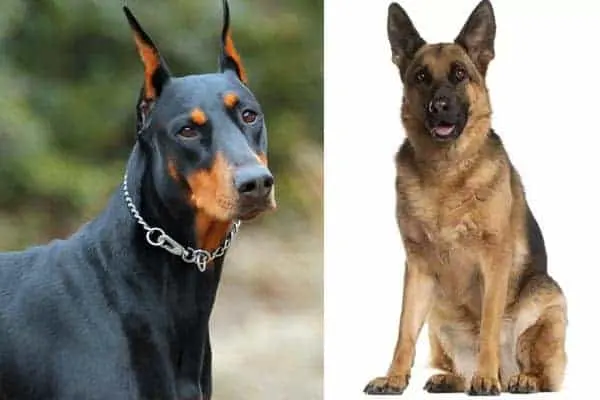
What Are The Exercise Requirements?
Both Dobermans and German Shepherds were bred to be versatile working dogs with excellent endurance.
Karl Friedrich Louis Dobermann perfected the Doberman so that it would be able to work tirelessly with him throughout the day and without complaint.
German Shepherds spent their days herding sheep and protecting them from dangerous predators.
GSDs and Pinschers are similar in that their strong work ethic and high intelligence necessitate both lots of exercise and plenty of social interaction.
Left to their own devices for long periods of time, or without sufficient exercise, can lead to more destructive behavior around the house and yard.
German Shepherds and Dobermans alike need as much as two hours of exercise per day.
You Won’t Be Able To Decide Based On Intelligence
Being such intelligent animals, both German Shepherds and Doberman Pinschers need plenty of mental stimulation to keep their active minds occupied.
Regular training, playing, and exercise are crucial for channeling their energy and aggression.
According to a psychological analysis released by Science Focus, both the German Shepherd and Doberman Pinscher rank in the top ten most intelligent dogs.
When it comes to training, Dobermans exhibit more willfulness, but German Shepherds will display dominant aggression more often.
Professionals do, however, consider both of them easy to train.
Nevertheless, experts don’t recommend them for first-time owners because establishing consistent control over Dobermans and Shepherds can be quite challenging.
These Dogs Have Much Different Temperaments
We know what personality traits Dobermans and German Shepherds have in common – they share loyalty, fearlessness, independence, protectiveness, and intelligence.
At this point, you may be thinking that other than a bushy tail, extra brushing, and some differences in appearance, German Shepherds and Doberman Pinscher are pretty much the same.
However, when analyzing differences in temperament and personality, we’ll start to notice more obvious distinctions between the breeds.
German Shepherds
German Shepherds originated from a long line of herding dogs, whereas the Doberman’s sole original purpose was as a protector of people and property.
The German Shepherd’s herding background developed their intelligence, cooperative mindset, and protective instincts that extend to groups as well as individuals.
In general, German Shepherds tend to be very smart and playful, yet task-oriented. Their willingness to please also makes them easy to train.
However, their high intensity and drive – common amongst herding breeds – can make them susceptible to anxiety and nervousness.
Doberman Pinscher
The Doberman Pinscher, who likely inherited traits from the Rottweiler, Manchester Terrier, German Pinscher, and Weimaraner, once had a well-established reputation for viciousness.
Using Dobermans as bodyguards, for property patrol, and in the military, handlers encouraged the dogs to be aggressive and intimidating.
Dobermans remain exceptional guard dogs, although breeders have successfully managed to produce a much friendlier version that is more suitable as a family pet.
With this in mind, German Shepherds are likely easier to train and better around children and other household pets.
German Shepherds tend to bond closely with one family member, much like a Doberman.
Dog aggression is an acceptable trait in the show ring for Dobermans and one that breeding has propagated for generations.
A well-bred Doberman, however, is more likely than a GSD to greet strangers in a friendly manner.
German Shepherds are often aloof, albeit civil, towards unfamiliar people.
For the most part, you should still use caution when introducing these dogs to your guests and other dogs.
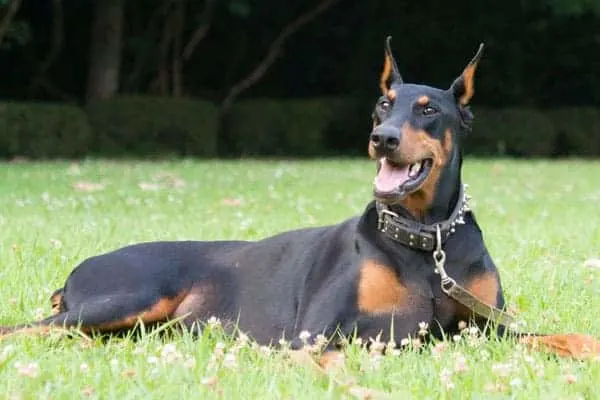
Which Is The Better Guard Dog, and Which Is More Dangerous?
Dobermans may seem more protective than German Shepherds, but this again relates to its origins.
In Dobermans, according to professional dog trainer John Soares, the hunter and mastiff-type ancestry cause them to vigorously defend their space – biting only as a last resort.
Dobermans will put on aggressive displays without any physical contact. However, reflective of the terrier and Molossoid influences, when a Doberman does bite, it’s with the full intent of causing harm.
German Shepherds, on the other hand, move more readily into an intruder’s space and give less warning before biting.
They bite more frequently, sometimes resorting to nipping and bumping. The focus of their bites is often control rather than bodily harm.
German Shepherds are involved in more biting incidents than Dobermans, and are only slightly behind Pit Bulls at No. 3 according to a new AAHA study.
Both dogs have excellent protective instincts and usually don’t require any guard training.
Some experts actually discourage formal protective training for German Shepherds or Dobermans, citing obedience as the more important goal.
Dobermans and German Shepherds have similar biting power. A Doberman has a stronger bite force at 305 pounds of pressure per square inch compared to the German Shepherd’s 238 pounds.
According to Doberman Planet, GSDs fall a little short of the average for pet dogs, which is 269 pounds of pressure per square inch.
Socialization is crucial for both dogs from a very early age. Territorial aggression can lead to serious consequences if not done properly.
This statement is true for pretty much any dog – they can become dangerous without proper training, socialization, and human interaction.
You may have insurance concerns
Insurance companies commonly place German Shepherds and Dobermans on uninsurable lists. Renting a property can be a hassle if you own an Alsatian or a Doberman.
Insurers will simply disregard your dog’s training or individual personality once a breed is ruled dangerous.
Is Apartment Living For a Large Breed Dog?
Provided you can have a Doberman or a German Shepherd in an apartment, should you even entertain the idea?
Dobermans are more mindful of space and would therefore be more adaptable to apartment living. But given the exercise requirements for these dogs, it’s definitely not recommended.
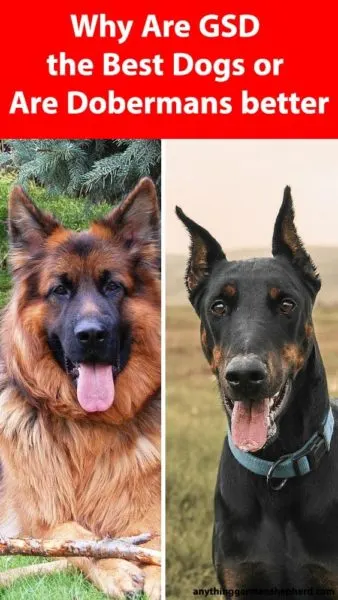
What Are The Health Issues For Dobermans and German Shepherds?
According to PetMD, another area in common for Dobermans and German Shepherds is their life expectancy. Both breeds live 10 to 13 years on average.
Unfortunately, they do suffer from common heritable ailments like many other purebred dogs.
Breeders can screen for some abnormalities which will decrease the likelihood of problems arising in their litters.
As large deep-chested breeds, both Dobermans and German Shepherds are susceptible to a condition called bloat.
The stomach swells to several times its regular size from gas and fluid build-up after a meal and other exacerbating conditions.
If the stomach then twists, it is known as volvulus and can be life-threatening.
Shepherds and Dobermans together are also vulnerable to hip dysplasia and corresponding arthritis, elbow dysplasia, diabetes, and structural eye problems.
Problems more common in German Shepherds
- Degenerative disc disease
- Hypothyroid disease – the thyroid has a lower activity than normal, requiring lifelong medication.
- Hemophilia – a clotting disorder that affects a different pathway than von Willebrand’s but has similar results.
- Epilepsy – seizure disorder that may be hereditary in some lines
Health issues more specific to Doberman Pinschers
- von Willebrand’s disease – clotting disorder diagnosed with special blood tests
- Demodicosis – a type of mite most common in puppies that have compromised immune systems
- Wobblers Disease – affects the vertebral column causing impingement on the spine
- Liver disease – some liver problems are hereditary in Dobermans.
- Parvo – a life-threatening virus that more commonly affects puppies with compromised immunities, causing bloody diarrhea and vomiting
- Dilatative cardiomyopathy – Dobermans are overrepresented. An enlarged heart chamber with thinning walls greatly shortens the lives of affected dogs.
Where Do Doberman Pinschers and German Shepherds Excel Outside of Family and Guard Duty?
A Doberman’s athleticism, bravery, and intelligence make it a formidable force in the military and police. With the proper training and guidance, the Doberman could also make an excellent therapy dog.
German Shepherds are among the most versatile working dogs, thanks to the foresight of von Stephanitz.
Their extreme focus has enabled them to become the gold standard in the military, and iconic figures in the police force.
There was even a time when German Shepherds were the only breed used as guide dogs for the blind.
If you are searching for activities that you can do with your Doberman or German Shepherd, try agility courses, Schutzhund, lure coursing, and flyball.
You could also partake in dock diving with your Doberman or herding trials with your Shepherd.
Our YouTube Video: German Shepherd vs Doberman Pinscher
Related Post: Should a Shepherd Doberman Mix Be At the Top of Your Best Dog Want List?
FAQ:
1) What are the similarities and differences between German Shepherds and Doberman Pinschers?
Answer: German Shepherds and Doberman Pinschers share similar physical attributes such as their large size, athleticism and coat color. They differ in appearance, with the Doberman being taller and more square, while the German Shepherd is stockier with a rectangular and sloping silhouette. They also have differences in temperament and personality, with German Shepherds being more task-oriented and dominant, while Dobermans are more protective and aggressive.
2) What are the exercise requirements for German Shepherds and Doberman Pinschers?
Answer: Both breeds were bred to be working dogs with excellent endurance and require as much as two hours of exercise per day. Regular training, playing, and exercise are crucial for channeling their energy and aggression. Lack of sufficient exercise can lead to destructive behavior around the house and yard.
3) What are some of the health issues that Doberman Pinschers and German Shepherds can face?
Answer: Both breeds suffer from common heritable ailments like many other purebred dogs, such as hip dysplasia, elbow dysplasia, diabetes, and structural eye problems. German Shepherds are more prone to degenerative disc disease, hypothyroid disease, hemophilia, and epilepsy, while Dobermans are more susceptible to von Willebrand’s disease, demodicosis, liver disease, and dilatative cardiomyopathy.
4) How do Doberman Pinschers and German Shepherds handle different weather conditions?
Answer: Doberman Pinschers with their short fur and thin undercoats do not adjust as naturally as German Shepherds to being outside in the frigid cold. German Shepherds, with their undercoats, are heat-tolerant and can insulate well in both cold and warm weather. It is still best to avoid excessive activity in extreme heat or cold and take frequent water breaks in the shade to cool them down.
5) Are German Shepherds and Doberman Pinschers suitable for apartment living?
Answer: Dobermans are more adaptable to apartment living given their disposition and smaller size, but the exercise requirements for these dogs make it not recommended. These breeds require plenty of mental stimulation and social interaction and may become destructive without sufficient exercise and human interaction.






























